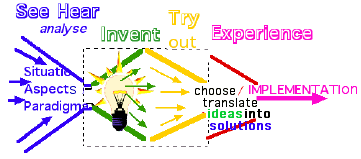Is the first (input) stage in creative thinking. It implies awareness of a particular situation and what leads you to explore it. Gulliver is able to loosen the strings but then becomes aware that he can better abide by the wishes of his captors. It is a logical-rational process that requires you to really see (i.e. 'looking is not the same as seeing'). Step 1 of the SHITE-process:

Analysis deals with the concrete facts; abstract things should be made 'physical', Every sailor starts by charting his route on a map. To make Gulliver's Travels realistic, Swift prefaced the book by two carefully composed fictitious letters, which facilitate the gradual shift from reality to fiction. He also provided fictitious maps and Gulliver makes many remarks on the inaccuracy of the current maps. When starting out to realize an idea we have to consciously move from reality to fiction, a fiction which finally must become reality.
It cannot mean wishful thinking, although there may be dream or wish. Analysis implies the orientation to find out if the dream can be realized. It is convenient to make use of a systematic procedure to keep track of what one is doing.
What it comes down to is looking. All art students start by copying nature and old masters. And although copied art is often considered second-rate it trains us in the art of seeing. The strength of the Japanese is based exactly on this art. Every student, be it judo, bonsai growing or sword-fighting starts with copying the master. copying 'real nature' makes one aware of how far one is still removed from it. Copying an example activates the imagination and tests our powers of visualization.
A suggested procedure:
1 Describe the present situation.
2 State the goals i.e. the desired situation.
3 Take different perspectives: Lilliput - Brobdingnag; small and big; different angles of analysis, e.g. human, technical, financial, organizational, procedural, motivational.....etc.
4 Draw a physical sketch of the situation; large white sheet and starting in the middle with different colours....
5 Check if there is enough information available, if not obtain this. Often one will be tempted to 'assume', always state why and when, for if the assumption is wrong, everything following it will be wrong as well. And if you don't know ASK (see answer).
6 Evaluation of pros and cons, possibilities and impossibilities; one can never solve everything at once. What to tackle first? Depending on the situation: Solve the most urgent problem first or solve the easiest problem first.
Thus the exact fields of investigation are clearly mapped. After that selection can take place and the stage of inventive search will be started.
It is always good to have started properly and aim for quantity, see 'ideas'. Anything overlooked at the start will cost double or more later on, both in terms of money and motivation.
[back to start Creativity Explored in Gulliver’s Footsteps]
[back to Index]